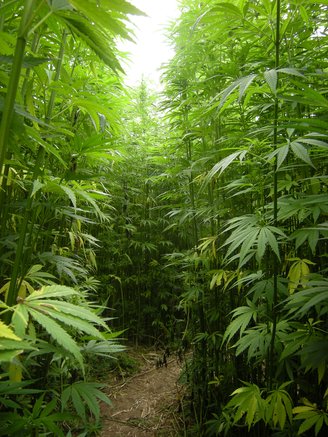UPDATE, Tuesday, 1:50 p.m.:
The Board of Supervisors today voted unanimously to send the proposed letter, with a minor edit to the wording. They also opted to send a copy to Karen Smith, director of the California Department of Public Health.
Humboldt County Planning & Building Director John H. Ford noted that the public perception, as expressed at a community meeting in SoHum last night, is that while medical marijuana is regulated, high-CBD hemp is not.
This was also demonstrated by the 40 hemp cultivation applications received by the county on the one day between hemp moratoriums last month. All 40 applicants intended to grow hemp for its CBD compound, Ford said, adding that the state government needs to take the lead.
Second District Supervisor Estelle Fennell suggested an edit to soften the criticism implied in the letter’s reference to growers who will call their cash crop “industrial hemp” just to avoid taxes and permitting requirements. The edited version said there’s merely a concern that such skulduggery might occur.
# # #
PREVIOUSLY:
- TODAY IN SUPES: Hemp Moratorium Reinstated
- County Ag Commissioner Accepting Hemp Registration Forms Ahead of Moratorium Vote
- Will a Lapse in the County’s Hemp Moratorium Inadvertently Open the Floodgates for Industrial Cultivation?
- County Looks to Extend Moratorium on Industrial Hemp Cultivation While Developing New Rules and Regulations
- Yurok Tribe Gives Thumbs-Up to Hemp: Tribal Council Moves to Legalize Non-Psychoactive Cannabis on Tribal Lands, Develop Regulations and Explore Business Opportunities Around Newly Legal Crop
# # #

As you can see from that bulleted list of headlines above, Humboldt County supervisors have been wrestling with the question of how to regulate high-CBD, low-THC cannabis now that the feds have legalized hemp cultivation.
Hemp is cannabis, albeit a distinct sativa strain grown with virtually none of the psychoactive compound tetrahydrocannabinol (THC). Historically hemp has been grown row crop-style for its fiber and seeds. But with the recent boom in CBD — the non-psychoactive cannabis compound being marketed far and wide as a virtual panacea — growers see hemp as a potentially lucrative cash crop that can be grown legally, outside of state and local regulations.
Two weeks ago the Board of Supervisors renewed a moratorium on hemp cultivation, giving staff some time to devise a plan for regulating the crop. Staff and supervisors worry that absent such regulations, a CBD hemp industry might undermine Humboldt’s nascent legal cannabis market.
Now the county is looking to the state to help solve the problem. On Tuesday the Board of Supervisors will consider approving a letter to various state officials asking that they clearly define industrial hemp in a way that addresses CBD.
Hemp already has a threshold for THC: If the crop contains more than 0.3 percent, it can’t be considered hemp.
“In Humboldt County,” this letter states, “there is a population of growers who will characterize their medicinal and recreational [cannabis] crops as industrial hemp for the sole purpose of avoiding permitting requirements as well as state and local taxes.”
Growers could also escape criminal liability with this approach.
“Such a result would be manifestly unfair to the cannabis growers who have worked so hard to come into compliance with the law,” the letter continues.
Drafts have been prepared for sending to Governor Gavin Newsom, Senator Mike McGuire, Assemblymember Jim Wood and California Department of Food and Agriculture Secretary Karen Ross.
Here’s the body of the letter:
We are writing today to draw your attention to a serious problem created because the existing definition of medicinal cannabis does not account for the widespread manufacturing, marketing, distribution, and sales of medicinal products containing cannabidiol (CBD). Due to this omission, cannabis plants with low THC and a high CDB content for medicinal purposes can be cultivated as industrial hemp so that they do not automatically come within the structure of the Medical Cannabis Regulation and Safety Act (MCRSA).
This discrepancy creates a loophole that undermines the ongoing efforts to regulate medicinal and recreational cannabis cultivation. Indeed, unless the Legislature acts quickly, individuals will be able to grow cannabis for medicinal use, while evading compliance with the state and local rules imposing environmental protections and health and safety measures, as well as the payment of state and local taxes.
The solution to the problem is uncomplicated. A simple revision to either Business and Professions Code section 26001 or Health and Safety Code section 11018.5 to add a threshold for CBD content in addition to the threshold for THC will ensure that all cannabis cultivated for medicinal purposes is subject to MCRSA.
The advantages of such a change are readily apparent. MCRSA already includes provisions for the testing and tracking of medicinal products that safeguard consumers. Public policy militates against weakening those safeguards. Furthermore, over the past two years, state and local agencies have worked diligently to establish a framework of environmental protections and land use rules consistent with MCRSA. There is no good reason to undercut their work.
In fact, the differences between crops grown as industrial hemp for CBD extraction and medicinal/recreational cannabis are difficult, if not impossible, to measure without inspection and testing. In Humboldt County, there is a population of growers who will characterize their medicinal and recreational crops as industrial hemp for the sole purpose of avoiding permitting requirements as well as state and local taxes. These growers may also be able to escape criminal penalties imposed pursuant to Health and Safety Code section 11357 et seq. Such a result would be manifestly unfair to the cannabis growers who have worked so hard to come into compliance with the law.
For all of these reasons, we urge you now to support the cannabis regulatory framework by taking immediate action to adopt a clear definition of industrial hemp that addresses CBD as well as THC.
The Board of Supervisors meeting is scheduled to begin at 9 a.m. at the Humboldt County Courthouse, 825 Fifth Street in Eureka.
CLICK TO MANAGE